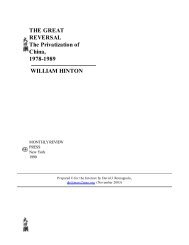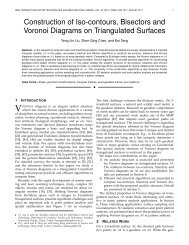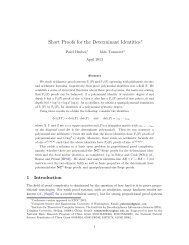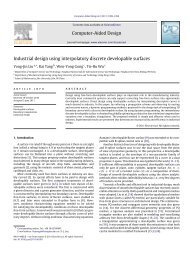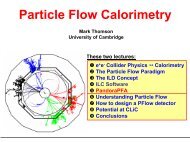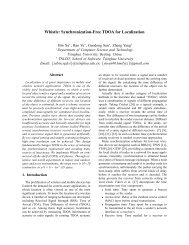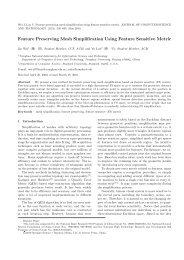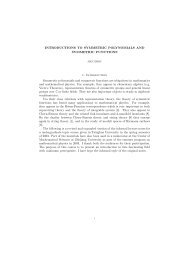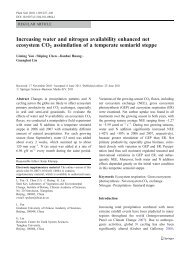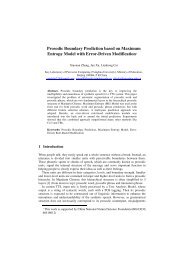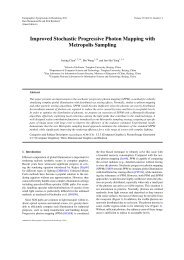Resonant tunneling through the repulsive Coulomb barrier of a ...
Resonant tunneling through the repulsive Coulomb barrier of a ...
Resonant tunneling through the repulsive Coulomb barrier of a ...
- No tags were found...
You also want an ePaper? Increase the reach of your titles
YUMPU automatically turns print PDFs into web optimized ePapers that Google loves.
PHYSICAL REVIEW A 85, 064503 (2012)<strong>Resonant</strong> <strong>tunneling</strong> <strong>through</strong> <strong>the</strong> <strong>repulsive</strong> <strong>Coulomb</strong> <strong>barrier</strong> <strong>of</strong> a quadruply charged molecular anionPhuong Diem Dau, 1 Hong-Tao Liu, 1 Ji-Ping Yang, 2,3 Marc-Oliver Winghart, 2 Thomas J. A. Wolf, 2 Andreas-Neil Unterreiner, 2Patrick Weis, 2 Yu-Run Miao, 4 Chuan-Gang Ning, 4,* Manfred M. Kappes, 2,5,† and Lai-Sheng Wang 1,‡1 Department <strong>of</strong> Chemistry, Brown University, Providence, Rhode Island 02912, USA2 Institut für Physikalische Chemie, Karlsruhe Institute <strong>of</strong> Technology, Kaiserstrasse 12, D-76128 Karlsruhe, Germany3 School <strong>of</strong> Electronic Science and Applied Physics, Hefei University <strong>of</strong> Technology, Hefei 230009, China4 Department <strong>of</strong> Physics, State Key Laboratory <strong>of</strong> Low-Dimensional Quantum Physics, Tsinghua University, Beijing 100084, China5 Institut für Nanotechnologie, Karlsruhe Institute <strong>of</strong> Technology, Postfach 3640, D-76021 Karlsruhe, Germany(Received 14 February 2012; published 25 June 2012)Multiply charged anions possess a <strong>repulsive</strong> <strong>Coulomb</strong> <strong>barrier</strong> (RCB) against electron emission, thus allowing forlong-lived metastable species with negative electron binding energies. For <strong>the</strong> prototypical multianion, bisdisulizoletetra-anion, we demonstrate that electronically excited states supported by <strong>the</strong> RCB can undergo resonant<strong>tunneling</strong>. The dynamics <strong>of</strong> this process was investigated by one-photon photoelectron imaging and femtosecondpump-probe photoelectron spectroscopy and confirmed by <strong>the</strong>oretical calculations. Efficient resonant <strong>tunneling</strong>emission <strong>of</strong> electrons from <strong>the</strong> excited states <strong>of</strong> multianions may be common for systems with sufficiently largeRCB. This may provide new opportunities to study electron emission dynamics in complex systems.DOI: 10.1103/PhysRevA.85.064503Multiply charged anions (MCAs) are common in <strong>the</strong>condensed phase [1]. However, if <strong>the</strong> counterions or solventsare removed, isolated MCAs in <strong>the</strong> gas phase becomera<strong>the</strong>r fragile and exhibit many unique physical propertiesdue to <strong>the</strong> strong intramolecular <strong>Coulomb</strong> repulsion [2–8].When an electron is emitted from a MCA, it experiences ashort-range attraction and a long-range repulsion from <strong>the</strong>remaining negative ion, resulting in a <strong>repulsive</strong> <strong>Coulomb</strong><strong>barrier</strong> (RCB). The RCB provides dynamic stability to MCAsand allows long-lived metastable MCAs with negative electronbinding energies to be observed [9–12]. Metastable MCAscan undergo spontaneous electron emission from <strong>the</strong>ir groundstates by <strong>tunneling</strong> <strong>through</strong> <strong>the</strong> RCB, analogous to α decayfor radioactive nuclei [11–16]. Such decay has been studiedusing ion trap mass spectrometry, yielding <strong>tunneling</strong> lifetimeson <strong>the</strong> order <strong>of</strong> seconds for a number <strong>of</strong> metastable MCAs atroom temperature [11,12,16].Photoelectron spectroscopy (PES) has been an importanttechnique to probe <strong>the</strong> RCB and electronic stability <strong>of</strong> MCAs[7,9,17]. In PES <strong>of</strong> MCAs, <strong>the</strong> detachment photon energiesmust be higher than <strong>the</strong> RCB. In o<strong>the</strong>r words, no slow electronscan be observed in PES <strong>of</strong> MCAs: The outgoing electrons musthave enough kinetic energy to overcome <strong>the</strong> RCB because <strong>the</strong>nonresonant <strong>tunneling</strong> probability is usually negligible exceptnear <strong>the</strong> very top <strong>of</strong> <strong>the</strong> RCB. Thus, PES spectra <strong>of</strong> MCAs <strong>of</strong>tendisplay a cut<strong>of</strong>f at <strong>the</strong> high binding energy side. Such spectralcut<strong>of</strong>f is a unique feature <strong>of</strong> MCAs, allowing <strong>the</strong> RCB heightsto be estimated [18]. However, if sufficiently long-lived excitedstates exist below <strong>the</strong> RCB, resonant <strong>tunneling</strong> can occur,producing electron detachment features beyond <strong>the</strong> spectralcut<strong>of</strong>f. <strong>Resonant</strong> <strong>tunneling</strong> was first suggested in PES <strong>of</strong>copper phthalocyanine tetrasulfonate tetra-anion [19], whichwas <strong>the</strong> first MCA observed to be metastable [9]. The relateddynamics has been investigated by pump-probe photoelectron* ningcg@mail.tsinghua.edu.cn† Manfred.Kappes@kit.edu‡ Lai-Sheng_Wang@brown.eduPACS number(s): 33.60.+q, 33.80.Eh, 36.90.+fspectroscopy, as well as in a number <strong>of</strong> o<strong>the</strong>r phthalocyaninebasedMCAs [20]. The latter study demonstrated that forcertain metastable, phthalocyanine-based multianions, excitedstate electron <strong>tunneling</strong> detachment may become fast enoughto compete with internal conversion. Such (resonant) <strong>tunneling</strong>from electronically excited states via <strong>the</strong> RCB <strong>of</strong> MCAsis interesting because it provides a unique opportunity tostudy electron emission and relaxation dynamics in complexsystems. However, among <strong>the</strong> many MCAs studied so far,resonant <strong>tunneling</strong> is rare—it has only been inferred in<strong>the</strong> phthalocyanine family <strong>of</strong> molecules. In retrospect, twoconditions must be met to allow resonant <strong>tunneling</strong> states.First, <strong>the</strong> RCB must be high enough to support an excited state.This usually means MCAs with more than two excess charges,which produce stronger intramolecular <strong>Coulomb</strong> repulsion anda higher RCB. Second, <strong>the</strong> parent molecule must have a richmanifold <strong>of</strong> excited states in <strong>the</strong> visible or near-ultravioletspectral region.Here we report a direct observation <strong>of</strong> a resonant <strong>tunneling</strong>state in <strong>the</strong> bisdisulizole tetra-anion [BDSZ 4− , see Fig. 1(a)],which was found to be a metastable MCA with a negativeelectron binding energy <strong>of</strong> − 0.8 eV and a RCB <strong>of</strong> 4.3 eV. First,<strong>the</strong> BSDZ 4− anion was studied using a magnetic-bottle PESapparatus and PE imaging. The <strong>tunneling</strong> state was observedto be at 3.2 eV above <strong>the</strong> ground state <strong>of</strong> <strong>the</strong> tetra-anion within<strong>the</strong> RCB. It was confirmed by <strong>the</strong>oretical calculations using <strong>the</strong>Wentzel-Kramers-Brillouin (WKB) <strong>the</strong>ory and investigatedby femtosecond pump-probe PES. This yielded a lifetime <strong>of</strong>450 fs for <strong>the</strong> resonant <strong>tunneling</strong> state.The PES experiment was performed with an electrosprayPES apparatus equipped with a magnetic-bottle electronanalyzer [17] and a velocity-map imaging detector [21]. Thetemporal dynamics <strong>of</strong> resonant states was investigated usingfemtosecond pump-probe PES [20]. The BDSZ 4− anions weregenerated by electrospray <strong>of</strong> a 2 mM solution <strong>of</strong> Na-BDSZdissolved in a mixed water and methanol solvent. Both <strong>the</strong>magnetic-bottle and imaging PES experiments were calibratedby <strong>the</strong> known spectra <strong>of</strong> Br − and I − . The electron kineticenergy resolution (E/E) was about 3%, i.e., ∼30 meV for1050-2947/2012/85(6)/064503(5) 064503-1©2012 American Physical Society
BRIEF REPORTS PHYSICAL REVIEW A 85, 064503 (2012)FIG. 1. (Color online) (a) Molecular structure <strong>of</strong> BDSZ 4− .(b)Photoelectron images <strong>of</strong> BDSZ 4− at 266 nm (top) and 355 nm (bottom),showing <strong>the</strong> perpendicular intensity distributions relative to <strong>the</strong>laser polarization indicated by <strong>the</strong> arrows. (c) Photoelectron spectra <strong>of</strong>BDSZ 4− converted from (b) by integrating <strong>the</strong> photoelectron intensityaround <strong>the</strong> circular images after reverse-Abel transformation.1.0-eV electrons. The corresponding energy resolution <strong>of</strong> <strong>the</strong>pump-probe apparatus was about 5%.Figures 1(b) and 1(c) show <strong>the</strong> results <strong>of</strong> PE imaging <strong>of</strong>BDSZ 4− . These data were presented in a recent study as anexample <strong>of</strong> perpendicular electron emission guided by <strong>the</strong>extra charges [22]. But <strong>the</strong> spectral features were not analyzed.The binding energy spectra [Fig. 1(c)] revealed that BDSZ 4−is metastable with negative electron binding energies. Twospectral bands were observed at 266 nm [Fig. 1(c)]: a broadlow-binding-energy band (X) with an adiabatic detachmentenergy (ADE) <strong>of</strong> − 0.8 eV and a sharper feature (T ) with awell-defined vertical detachment energy (VDE) <strong>of</strong> 0.7 eV. The355-nm spectrum showed only one band: It was expected that<strong>the</strong> higher-binding-energy band at 266 nm would be cut <strong>of</strong>fdue to <strong>the</strong> RCB. However, <strong>the</strong> 355-nm spectrum was puzzlingin two aspects: (1) The ADE <strong>of</strong> <strong>the</strong> band at 355 nm (–0.7eV) was not consistent with that <strong>of</strong> band X in <strong>the</strong> 266-nmspectrum (–0.8 eV); (2) <strong>the</strong> band in <strong>the</strong> 355-nm spectrumdid not resemble band X in <strong>the</strong> 266-nm spectrum, but ra<strong>the</strong>rappeared more like <strong>the</strong> higher-binding-energy band (T ) shiftedto a lower binding energy. To better understand <strong>the</strong>se spectralfeatures and <strong>the</strong>ir photon energy dependence, we studiedBDSZ 4− with our magnetic-bottle PES apparatus at a moreextended photon energy range using a Nd:YAG laser (355 and266 nm), a tunable dye laser (412, 305, 280, and 206 nm), andan F2 excimer laser (157 nm).The more extended PES data set is displayed in Fig. 2(a).At157 nm (7.87 eV), broad and near-continuous spectral featuresFIG. 2. Photoelectron spectra <strong>of</strong> bisdisulizole tetra-anion(BDSZ 4− ) at 412 nm (3.01 eV), 355 nm (3.49 eV), 305 nm (4.09 eV),280 nm (4.43 eV), 266 nm (4.66 eV), 206 nm (6.02 eV), and 157 nm(7.87 eV) plotted versus (a) <strong>the</strong> electron binding energy and (b) <strong>the</strong>photoelectron kinetic energy.were observed between − 1 and 4 eV. At 206 nm (6.02 eV),spectral features above 2.5 eV were cut <strong>of</strong>f due to <strong>the</strong> RCB, asexpected. However, a relatively sharp band (T ) appeared at <strong>the</strong>high-binding-energy side. As <strong>the</strong> photon energy continued todecrease, more spectral features were cut <strong>of</strong>f, but a sharp bandon <strong>the</strong> high-binding-energy side seemed to be present in all<strong>the</strong> spectra down to 355 nm. Finally, at 412 nm (3.01 eV), nophotoelectron signals were observed, suggesting <strong>the</strong> photonenergy must be below <strong>the</strong> RCB. Surprisingly, when we plotted<strong>the</strong> PES spectra in kinetic energies [Fig. 2(b)], we found that<strong>the</strong> high-binding-energy feature (T ) lined up in all <strong>the</strong> spectrawith <strong>the</strong> same nominal kinetic energy <strong>of</strong> 4.0 eV, including <strong>the</strong>weak high-binding-energy feature in <strong>the</strong> 157-nm spectrum.This feature (T ) could not come from direct photodetachment.The same kinetic energy at different detachmentphoton energies suggested that this band came from <strong>the</strong> sameautodetachment state, i.e., a resonant <strong>tunneling</strong> state within <strong>the</strong>RCB. How was this resonant state produced in <strong>the</strong> first place?BDSZ is a well-known, strong UV absorber used commerciallyin sunscreens [23]. In aqueous solution, it has a strong UVabsorption band centered at 335 nm (with an onset near380 nm), overlapping with o<strong>the</strong>r higher-energy-absorptionfeatures [23]. Thus, no matter what UV wavelengths wereused in <strong>the</strong> photodetachment, a resonant absorption occurred toproduce a highly excited tetra-anion, (BSDZ 4− ) ∗ , which <strong>the</strong>nrelaxed to a common lower state (most likely <strong>the</strong> lowest singletexcited state), from which resonant <strong>tunneling</strong> took place. ThePES spectral features with kinetic energies higher than <strong>the</strong>064503-2
BRIEF REPORTS PHYSICAL REVIEW A 85, 064503 (2012)FIG. 3. (Color online) (a) The model <strong>repulsive</strong> <strong>Coulomb</strong> potentialused for calculating <strong>the</strong> energy level and lifetime <strong>of</strong> <strong>the</strong> resonantstate with WKB <strong>the</strong>ory. The distance is in atomic units (1 a.u. =0.529 Å). The marked energy levels were determined from <strong>the</strong>observed photoelectron spectra. The vertical blue arrow stands for<strong>the</strong> excitation from a valence state to an excited state <strong>of</strong> BDSZ 4− ,and<strong>the</strong> resonant <strong>tunneling</strong> state is represented by <strong>the</strong> red horizontal line.The dotted arrow indicates <strong>the</strong> electron <strong>tunneling</strong>. (b) Transmissionyield calculated using WKB <strong>the</strong>ory for <strong>the</strong> model <strong>barrier</strong> potentialand resonant <strong>tunneling</strong> state indicated vs <strong>the</strong> emitted electron energy.The peak at 4.0 eV reflects <strong>the</strong> resonant state within <strong>the</strong> RCB.<strong>tunneling</strong> signals come from direct photodetachment, whichcannot compete with resonant <strong>tunneling</strong> as <strong>the</strong> photon energyis decreased.From <strong>the</strong> true spectral cut<strong>of</strong>f, we estimated a RCB height<strong>of</strong> 4.3 eV based on <strong>the</strong> 157-nm spectrum, where <strong>the</strong> resonant<strong>tunneling</strong> signal was relatively weak. The ADE for BDSZ 4−can only be evaluated from <strong>the</strong> spectra at photon energies above355 nm, because <strong>the</strong> 355-nm spectrum was entirely due to <strong>the</strong>resonant <strong>tunneling</strong> state. The ADE <strong>of</strong> BDSZ 4− was estimatedas − 0.8 eV from <strong>the</strong> 266-nm spectrum. Based on <strong>the</strong> ADE <strong>of</strong>BDSZ 4− and <strong>the</strong> 4.0-eV nominal kinetic energy <strong>of</strong> <strong>the</strong> resonant<strong>tunneling</strong> band, we estimated that <strong>the</strong> <strong>tunneling</strong> state is about∼3.2 eV above <strong>the</strong> ground state <strong>of</strong> <strong>the</strong> tetra-anion and ∼0.3 eVbelow <strong>the</strong> RCB top, as shown schematically in Fig. 3(a).The412-nm (3.01-eV) detachment energy was below <strong>the</strong> RCB andwas also below <strong>the</strong> resonant state. Thus, no electron signalswere observed at this detachment wavelength (Fig. 2).It should be noted that <strong>the</strong> angular distribution <strong>of</strong> <strong>the</strong>electrons corresponding to <strong>the</strong> resonant <strong>tunneling</strong> band ishighly perpendicular. As shown in Fig. 1(b), <strong>the</strong> photoelectronintensity at <strong>the</strong> direction perpendicular to <strong>the</strong> laser polarizationis much stronger than in <strong>the</strong> direction parallel to <strong>the</strong> laserpolarization. The perpendicular angular distribution is due to<strong>the</strong> anisotropy <strong>of</strong> <strong>the</strong> RCB caused by <strong>the</strong> terminal negativecharges, because <strong>the</strong> electrons are emitted from molecularorbitals in <strong>the</strong> middle <strong>of</strong> <strong>the</strong> BDSZ 4− anion [Fig. 1(a)],as reported recently [22]. The observed highly anisotropicelectron distribution also means that <strong>the</strong> resonant <strong>tunneling</strong>is a very fast process, relative to <strong>the</strong> rotational period <strong>of</strong>BDSZ 4− . The rotational constant B <strong>of</strong> BDSZ 4− for <strong>the</strong>rotation around its C 2 symmetry axis was calculated to be0.017 GHz [24]. At room temperature (T = 300 K), <strong>the</strong>population at various rotational levels is governed by <strong>the</strong>Boltzmann distribution, ∝ (2J + 1) exp[−hBJ (J + 1)/kT],where k is <strong>the</strong> Boltzmann constant and h is <strong>the</strong> Planckconstant. Thus, <strong>the</strong> most probable rotational quantum numberJ max ≈ (kT/2hB) 1/2 or ∼430, which has a rotational period <strong>of</strong>t r ≈ 1/(2BJ max ) ≈ 6.8 × 10 −11 s (68 ps). Hence, <strong>the</strong> lifetime<strong>of</strong> <strong>the</strong> resonant <strong>tunneling</strong> state should be much shorterthan 68 ps.To quantitatively understand <strong>the</strong> resonant <strong>tunneling</strong> state in<strong>the</strong> RCB, we calculated <strong>the</strong> potential <strong>barrier</strong> for <strong>the</strong> emission<strong>of</strong> an electron from <strong>the</strong> highest occupied molecular orbital<strong>of</strong> BDSZ 4− , using <strong>the</strong> DFT-B3LYP/6-311 ++G ∗∗ method[22,24] with <strong>the</strong> frozen static orbital approximation [25]. Thelowest RCB is along <strong>the</strong> y axis, which is perpendicular to <strong>the</strong>long molecular axis [Fig. 1(a)], as expected. The calculatedlowest RCB is 4.4 eV, in excellent agreement with <strong>the</strong> valueestimated from <strong>the</strong> cut<strong>of</strong>f <strong>of</strong> <strong>the</strong> PES spectra (∼4.3 eV). Tosimplify <strong>the</strong> calculation <strong>of</strong> electron <strong>tunneling</strong> with <strong>the</strong> WKB<strong>the</strong>ory [26], a one-dimensional double <strong>barrier</strong> along <strong>the</strong> yaxis was modeled to approximate <strong>the</strong> anisotropic RCB. Anaveraged potential inside <strong>the</strong> model <strong>barrier</strong> was taken as anadjustable parameter for producing <strong>the</strong> best agreement with<strong>the</strong> observed energy level <strong>of</strong> <strong>the</strong> resonant state. Indeed, wereproduced a resonant <strong>tunneling</strong> state with an energy level <strong>of</strong>4.0 eV. Figure 3(b) shows <strong>the</strong> transmission curve versus <strong>the</strong>electron energy. Since <strong>the</strong> measured energy distribution <strong>of</strong> <strong>the</strong><strong>tunneling</strong> state (T in Fig. 2) is a complicated convolution<strong>of</strong> Frank-Condon overlaps and vibrational excitations, aswell as instrumental energy resolution, it cannot be usedfor estimating <strong>the</strong> lifetime. However, <strong>the</strong> simulated energywidth <strong>of</strong> <strong>the</strong> resonant state (E = 0.07 eV) in Fig. 3(b)can be used to obtain a first-order estimate <strong>of</strong> <strong>the</strong> lifetimeτ (τ ∼ ¯h/E) <strong>of</strong> <strong>the</strong> resonant state to be ∼10 −14 s(∼10 fs).The overall pr<strong>of</strong>ile is not in good agreement with <strong>the</strong> measuredenergy distribution, which might be due to <strong>the</strong> oversimplified<strong>barrier</strong> model (in addition to <strong>the</strong> factors already mentionedabove).The temporal dynamics <strong>of</strong> <strong>the</strong> resonant state in BDSZ 4− wasdirectly investigated using femtosecond PES [20]. The pumpand probe laser pulses were provided using a fully integrated1 kHz Ti:sapphire femtosecond laser system (Clark-MXR,CPA-2001), which can yield 775-nm (1.6-eV) pulses withan overall pulse energy <strong>of</strong> 1 mJ. After second harmonicgeneration, pump (388-nm, 3.2-eV) and probe (775-nm) laserpulses were separated and delayed relative to each o<strong>the</strong>r usinga computer-controlled optical delay line (Nanomover, MellesGriot). For time-resolved PES, typical pump pulse energieswere 20 μJ in order to minimize two-photon detachment.Probe pulse energies were typically 120–140 μJ. The pumpprobetime resolution in <strong>the</strong> detachment region <strong>of</strong> <strong>the</strong> PEspectrometer was determined as 440 ± 30 fs by crosscorrelationmeasurements <strong>of</strong> pump and probe laser beams[see <strong>the</strong> dashed curve in Fig. 4(b)].Figure 4(a) shows <strong>the</strong> pump-probe results for BDSZ 4− .The strong peak in <strong>the</strong> photoelectron intensity at an electronkinetic energy <strong>of</strong> 4.0 eV corresponds to <strong>the</strong> resonant <strong>tunneling</strong>signal resulting from <strong>the</strong> BDSZ 4− molecules, which haveabsorbed one photon from <strong>the</strong> 388-nm pump radiation.The weaker signal in <strong>the</strong> kinetic energy range from 4.6 to5.7 eV corresponds to <strong>the</strong> two-color pump-probe transient064503-3
BRIEF REPORTS PHYSICAL REVIEW A 85, 064503 (2012)resonant <strong>tunneling</strong> state—as prepared by <strong>the</strong> absorption <strong>of</strong> onepump photon. The inset in Fig. 4(a) displays more details <strong>of</strong><strong>the</strong> pump-probe transient signal and <strong>the</strong> associated dynamics.With increasing pump-probe delay, <strong>the</strong> transient signal rapidlydecays as population is lost from <strong>the</strong> 3.2-eV <strong>tunneling</strong> state.No transient signal is observed for pump-probe delays beyond4.48 ps. Figure 4(b) shows <strong>the</strong> integrated transient signalintensity versus <strong>the</strong> pump-probe delay. This intensity curvewas fitted with a single exponential decay to obtain <strong>the</strong>effective lifetime <strong>of</strong> <strong>the</strong> <strong>tunneling</strong> state by also taking intoaccount <strong>the</strong> experimental time resolution. This yields a timeconstant <strong>of</strong> 450 ± 90 fs, which is comparable to <strong>the</strong> timeresolution <strong>of</strong> <strong>the</strong> experiment. We note that this lifetime isconsistent with <strong>the</strong> inference from <strong>the</strong> angular distributions,which show that <strong>tunneling</strong> emission from <strong>the</strong> 3.2-eV excitedstate is complete within a molecular rotational period. It is alsoconsistent with (but somewhat above) <strong>the</strong> lifetime estimatedfrom WKB <strong>the</strong>ory using <strong>the</strong> model RCB.In conclusion, resonant <strong>tunneling</strong> <strong>through</strong> <strong>the</strong> <strong>repulsive</strong><strong>Coulomb</strong> <strong>barrier</strong> <strong>of</strong> a quadruply charged anion has been explored.The energetics and dynamics <strong>of</strong> <strong>the</strong> resonant state wereinvestigated using one-photon photoelectron spectroscopyand imaging, <strong>the</strong>oretical calculations, and two-color, timeresolvedpump-probe photoelectron spectroscopy. <strong>Resonant</strong>states within <strong>the</strong> RCB may be quite common in complexMCAs. Investigation <strong>of</strong> <strong>the</strong> resonant <strong>tunneling</strong> via RCBmay open up new opportunities for investigating <strong>the</strong> uniqueproperties <strong>of</strong> multiply charged anions and electron emissiondynamics in complex systems.FIG. 4. (Color online) (a) Pump-probe photoelectron spectra <strong>of</strong>BDSZ 4− at <strong>the</strong> indicated delay times. The inset displays an expandedscale (15 × ) <strong>of</strong> <strong>the</strong> transient signal corresponding to photodetachmentfrom <strong>the</strong> <strong>tunneling</strong> state. (b) (Blue circles) integrated photoelectronsignals from <strong>the</strong> 4.6–5.7 eV transient region vs <strong>the</strong> pump-probe delay;(red line) a single exponential fit; (black dashed line) time resolutionfrom laser cross-correlation measurement (both in arbitrary units).process. Here interaction with a 775-nm probe photon leadsto photodetachment <strong>of</strong> electrons from <strong>the</strong> 3.2-eV transientACKNOWLEDGMENTSThe experiments done at Brown were supported by <strong>the</strong>National Science Foundation (Grant No. CHE-1049717 toL.S.W.). The experiments done at KIT were supported by <strong>the</strong>Deutsche Forschungsgemeinschaft (CFN C3.2 to M.M.K.).M.Y.R. and N.C.G. would like to acknowledge <strong>the</strong> NationalNatural Science Foundation <strong>of</strong> China for partial support <strong>of</strong> thiswork (Grant No. 11174175).[1] J. Simons, J. Phys. Chem. A 112, 6401 (2008).[2] S. N. Schauer, P. Williams, and R. N. Compton, Phys. Rev. Lett.65, 625 (1990).[3] J. Kalcher and A. F. Sax, Chem. Rev. 94, 2291 (1994).[4] M. K. Scheller, R. N. Compton, and L. S. Cederbaum, Science270, 1160 (1995).[5] A. I. Boldyrev, M. Gutowski, and J. Simons, Acc. Chem. Res.29, 497 (1996).[6] G. R. Freeman and N. H. March, J. Phys. Chem. 100, 4331(1996).[7] L. S. Wang and X. B. Wang, J. Phys. Chem. A 104, 1978(2000).[8] A. Dreuw and L. S. Cederbaum, Chem. Rev. 102, 181 (2002).[9] X. B. Wang and L. S. Wang, Nature 400, 245 (1999).[10] S. Tomita et al., J. Chem. Phys. 124, 024310 (2006).[11] K. Arnold, T. S. Balaban, M. N. Blom, O. T. Ehrler, S. Gilb,O. Hampe, J. E. v. Lier, J. M. Weber, and M. M. Kappes,J. Phys. Chem. A 107, 794 (2003).[12] X. B. Wang, A. P. Sergeeva, X. P. Xing, M. Massaout,T. Karpuschkin, O. Hampe, A. I. Boldyrev, M. M. Kappes, andL. S. Wang, J. Am. Chem. Soc. 131, 9836 (2009).[13] R. N. Compton, A. A. Tuinman, C. E. Klots, M. R. Pederson,andD.C.Patton,Phys. Rev. Lett. 78, 4367 (1997).[14] X. B. Wang, C. F. Ding, and L. S. Wang, Chem. Phys. Lett. 307,391 (1999).[15] M. N. Blom, O. Hampe, S. Gilb, P. Weis, and M. M. Kappe, J.Chem. Phys. 115, 3690 (2001).[16] S. Panja et al., J. Chem. Phys. 127, 124301 (2007).[17] L. S. Wang, C. F. Ding, X. B. Wang, and S. E. Barlow, Rev. Sci.Instrum. 70, 1957 (1999).[18] L. S. Wang, C. F. Ding, X. B. Wang, and J. B. Nicholas, Phys.Rev. Lett. 81, 2667 (1998).[19] X. B. Wang, K. Ferris, and L. S. Wang, J. Phys. Chem. A 104,25 (2000).[20] O. T. Ehrler, J. P. Yang, A. B. Sugiharto, A. N. Unterreiner, andM. M. Kappes, J. Chem. Phys. 127, 184301 (2007).064503-4
BRIEF REPORTS PHYSICAL REVIEW A 85, 064503 (2012)[21] X. P. Xing, X. B. Wang, and L. S. Wang, J. Chem. Phys. 130,074301 (2009).[22] C. G. Ning, P. D. Dau, and L. S. Wang, Phys.Rev.Lett.105,263001 (2010).[23] http://products.symrise.com/fileadmin/user_upload/lifeessentials/pdf/NeoHeliopan-AP.pdf.[24] The molecular structure was optimized with density functional<strong>the</strong>ory (DFT) using <strong>the</strong> B3LYP functional with a 6-311 ++G ∗∗Pople basis set. The electron density distribution <strong>of</strong> each molecularorbital was also obtained with <strong>the</strong> B3LYP/6-311 ++G ∗∗method. The GAUSSIAN 03code was used for <strong>the</strong> calculation:M. J. Frisch et al., GAUSSIAN 03, revision E.01, Gaussian, Inc.,Pittsburgh, PA, 2003.[25] A. Dreuw and L. S. Cederbaum, Phys.Rev.A63, 049904(E)(2001).[26] P. E. Hodgson, E. Gadioli, and E. G. Erba, IntroductoryNuclear Physics (Oxford University Press, Oxford,1997).064503-5



